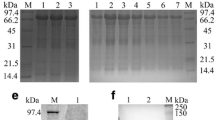Abstract
The herpes simplex virus 1 (HSV-1) portal protein UL6 is important for HSV-1 replication, however, its precise functions in the virus life cycle are poorly understood. As we known, a relatively important tool for disclosing these functions is the antiserum specifically detecting UL6 in the HSV-1-infected cell. To this end, a recombinant protein consisting of C-terminal 297–676 amino acids of UL6 fused to His-tag was expressed in E. coli and purified from inclusion body by the Ni2+-NTA affinity chromatography under denaturing conditions, which was then refolded and used for the preparation of antiserum in rabbit. As results, western blot and immunofluorescence assay showed that this antiserum could specifically detect the purified truncated UL6 as well as native UL6 in the HSV-1 infected cells, indicating that the prepared antiserum could serve as a valuable tool for further exploring the functions of UL6.




Similar content being viewed by others
References
Newcomb WW, Juhas RM, Thomsen DR, Homa FL, Burch AD, Weller SK, Brown JC (2001) The UL6 gene product forms the portal for entry of DNA into the herpes simplex virus capsid. J Virol 75(22):10923–10932. doi:10.1128/JVI.75.22.10923-10932.2001
Patel AH, Rixon FJ, Cunningham C, Davison AJ (1996) Isolation and characterization of herpes simplex virus type 1 mutants defective in the UL6 gene. Virology 217(1):111–123. doi:10.1006/viro.1996.0098
Wills E, Scholtes L, Baines JD (2006) Herpes simplex virus 1 DNA packaging proteins encoded by UL6, UL15, UL17, UL28, and UL33 are located on the external surface of the viral capsid. J Virol 80(21):10894–10899. doi:10.1128/JVI.01364-06
Albright BS, Nellissery J, Szczepaniak R, Weller SK (2011) Disulfide bond formation in the herpes simplex virus 1 UL6 protein is required for portal ring formation and genome encapsidation. J Virol 85(17):8616–8624. doi:10.1128/JVI.00123-11
Patel AH, MacLean JB (1995) The product of the UL6 gene of herpes simplex virus type 1 is associated with virus capsids. Virology 206(1):465–478
Thurlow JK, Rixon FJ, Murphy M, Targett-Adams P, Hughes M, Preston VG (2005) The herpes simplex virus type 1 DNA packaging protein UL17 is a virion protein that is present in both the capsid and the tegument compartments. J Virol 79(1):150–158. doi:10.1128/JVI.79.1.150-158.2005
Yang K, Baines JD (2009) Tryptophan residues in the portal protein of herpes simplex virus 1 critical to the interaction with scaffold proteins and incorporation of the portal into capsids. J Virol 83(22):11726–11733. doi:10.1128/JVI.01463-09
Yang K, Wills E, Baines JD (2009) The putative leucine zipper of the UL6-encoded portal protein of herpes simplex virus 1 is necessary for interaction with pUL15 and pUL28 and their association with capsids. J Virol 83(9):4557–4564. doi:10.1128/JVI.00026-09
Nellissery JK, Szczepaniak R, Lamberti C, Weller SK (2007) A putative leucine zipper within the herpes simplex virus type 1 UL6 protein is required for portal ring formation. J Virol 81(17):8868–8877. doi:10.1128/JVI.00739-07
Tanaka M, Kagawa H, Yamanashi Y, Sata T, Kawaguchi Y (2003) Construction of an excisable bacterial artificial chromosome containing a full-length infectious clone of herpes simplex virus type 1: viruses reconstituted from the clone exhibit wild-type properties in vitro and in vivo. J Virol 77(2):1382–1391
Li ML, Wang S, Cai MS, Zheng CF (2011) Identification of nuclear and nucleolar localization signals of pseudorabies virus (PRV) early protein UL54 reveals that its nuclear targeting is required for efficient production of PRV. J Virol 85(19):10239–10251. doi:10.1128/JVI.05223-11
Li ML, Li Z, Li WT, Wang BY, Ma CQ, Chen JH, Cai MS (2012) Preparation and characterization of an antiserum against truncated UL54 protein of pseudorabies virus. Acta Virol 56(4):315–322
Lin F, Ren X, Guo H, Ding Q, Zheng AC (2010) Expression, purification of the UL3 protein of herpes simplex virus type 1, and production of UL3 polyclonal antibody. J Virol Methods 166(1–2):72–76. doi:10.1016/j.jviromet.2010.02.022
Mierendorf RC, Morris BB, Hammer B, Novy RE (1998) Expression and purification of recombinant proteins using the pET system. Methods Mol Med 13:257–292. doi:10.1385/0-89603-485-2:257
Studier FW, Rosenberg AH, Dunn JJ, Dubendorff JW (1990) Use of T7 RNA polymerase to direct expression of cloned genes. Methods Enzymol 185:60–89
Bresnahan WA, Shenk TE (2000) UL82 virion protein activates expression of immediate early viral genes in human cytomegalovirus-infected cells. Proc Natl Acad Sci USA 97(26):14506–14511. doi:10.1073/pnas.97.26.14506
Cai W, Schaffer PA (1992) Herpes simplex virus type 1 ICP0 regulates expression of immediate-early, early, and late genes in productively infected cells. J Virol 66(5):2904–2915
Moore DM, Zsak L, Neilan JG, Lu Z, Rock DL (1998) The African swine fever virus thymidine kinase gene is required for efficient replication in swine macrophages and for virulence in swine. J Virol 72(12):10310–10315
Nevins JR (1981) Mechanism of activation of early viral transcription by the adenovirus E1A gene product. Cell 26(2 Pt 2):213–220 0092-8674(81)90304-4 [pii]
Kawaguchi Y, Bruni R, Roizman B (1997) Interaction of herpes simplex virus 1 alpha regulatory protein ICP0 with elongation factor 1delta: ICP0 affects translational machinery. J Virol 71(2):1019–1024
Feng ZP (2002) An overview on predicting the subcellular location of a protein. Silico Biol 2(3):291–303 2002020027 [pii]
Cai MS, Wang S, Xing JJ, Zheng CF (2011) Characterization of the nuclear import and export signals, and subcellular transport mechanism of varicella-zoster virus ORF9. J Gen Virol 92(Pt 3):621–626. doi:10.1099/vir.0.027029-0
Lamberti C, Weller SK (1996) The herpes simplex virus type 1 UL6 protein is essential for cleavage and packaging but not for genomic inversion. Virology 226(2):403–407. doi:10.1006/viro.1996.0668
Acknowledgments
This work was supported by grants from the National Natural Science Foundation of China (31200120); the Natural Science Foundation of Guangdong Province (S2013040016596); the Foundation for Distinguished Young Talents in Higher Education of Guangdong, China (2013LYM_0096); the Science and Technology New Star in Zhu Jiang, Guangzhou City (2013J2200018); and the First Batch of Young Core Instructor of Guangzhou Medical University. Dr. Yasushi Kawaguchi is gratefully acknowledged for generous gift pYEbac102.
Author information
Authors and Affiliations
Corresponding author
Rights and permissions
About this article
Cite this article
Li, M., Cui, W., Mo, C. et al. Cloning, expression, purification, antiserum preparation and its characteristics of the truncated UL6 protein of herpes simplex virus 1. Mol Biol Rep 41, 5997–6002 (2014). https://doi.org/10.1007/s11033-014-3477-y
Received:
Accepted:
Published:
Issue Date:
DOI: https://doi.org/10.1007/s11033-014-3477-y




